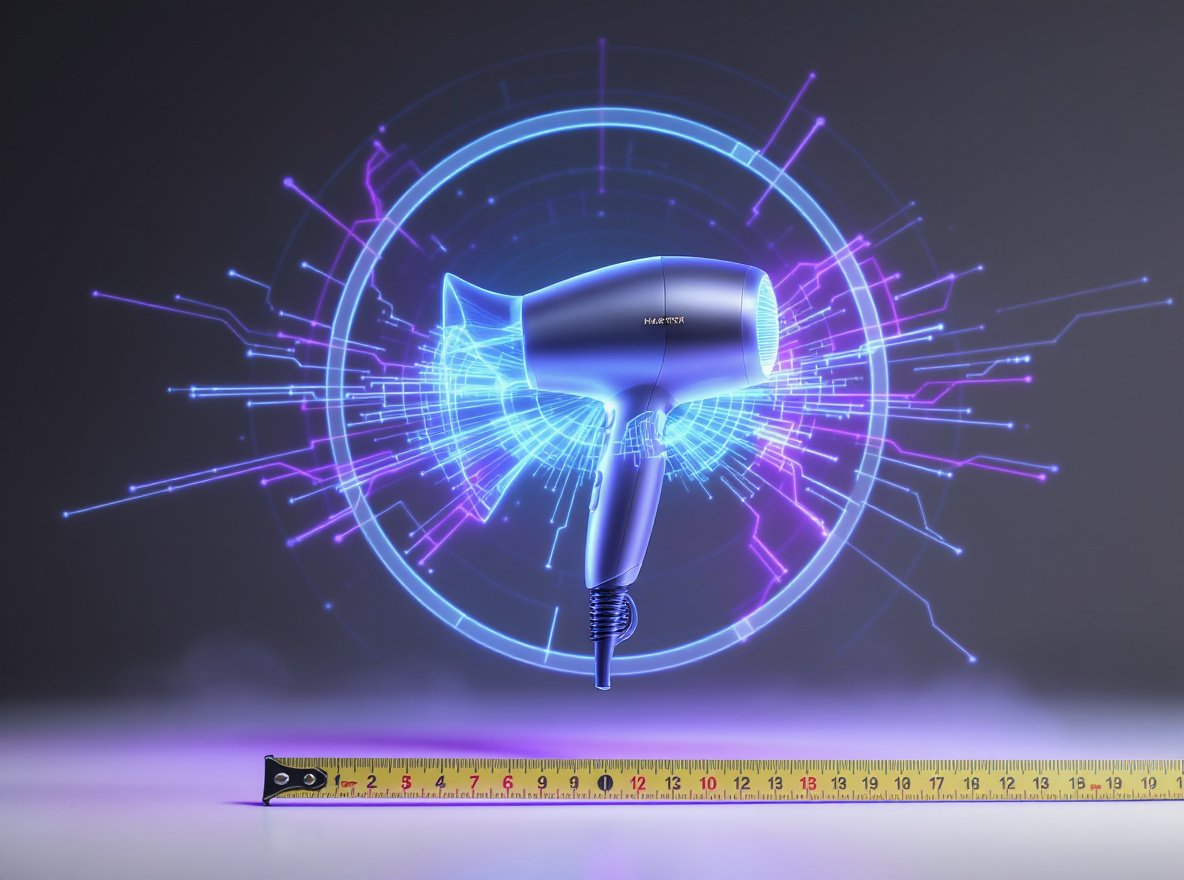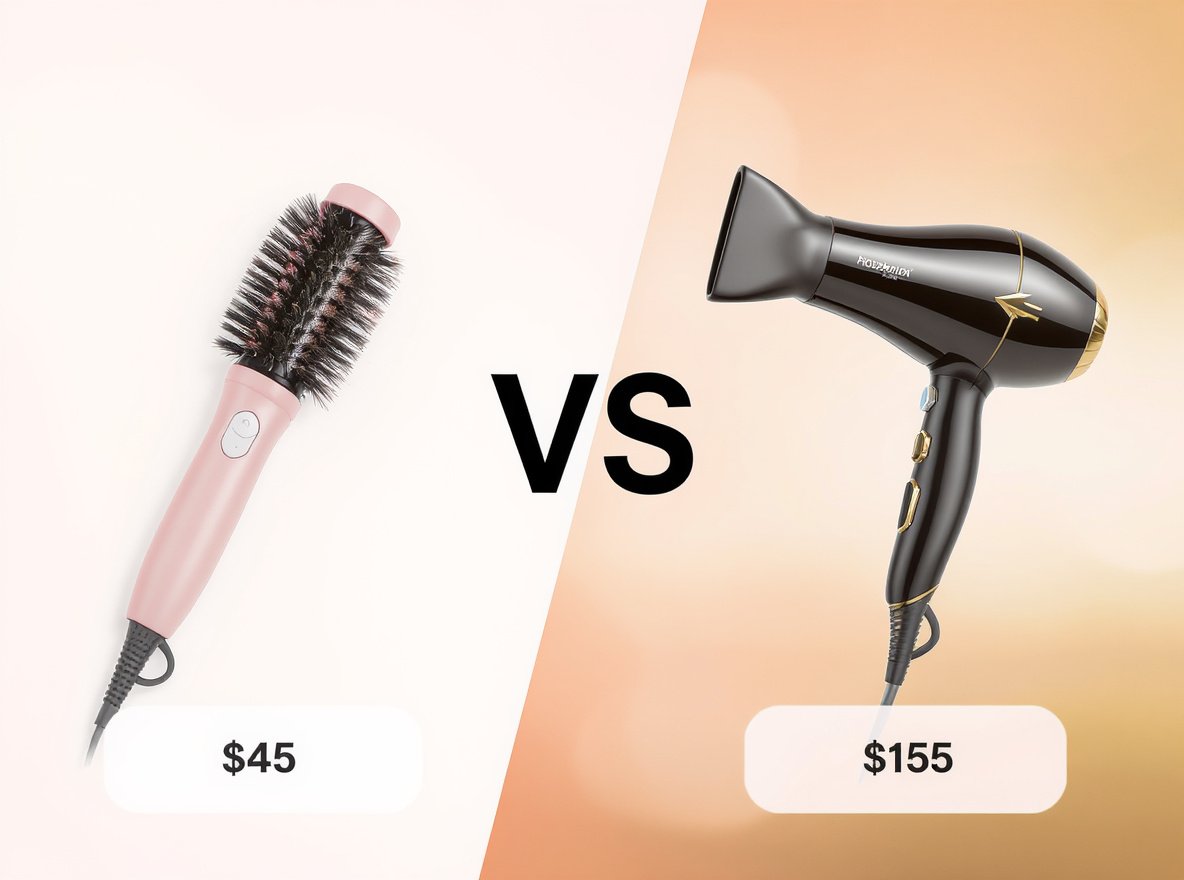You’ve probably heard conflicting advice about hair dryers – some say they’re essential for healthy styling, others claim they’re damaging your hair with every use. This confusion leaves many wondering whether their daily blow-drying routine is helping or harming their hair health.
Hair dryers can damage hair if used incorrectly or excessively, but with proper technique and the right tools, they can be used safely and even offer some benefits. Studies show that using a hair dryer at moderate temperature (around 117°F/47°C) and at least 6 inches away with continuous movement can actually cause less damage than air drying.
But there’s much more to this story. Understanding the science behind hair damage, learning proper techniques, and choosing the right equipment can transform your hair care routine from potentially damaging to genuinely beneficial.
Table of Contents
ToggleDo Hair Dryers Really Damage Your Hair?
Many people assume that any heat applied to hair automatically causes damage, but research reveals a more nuanced relationship between heat styling and hair health.
Hair dryers can cause surface damage to the hair shaft when used at high temperatures and close distances, leading to roughness, dryness, and color loss. However, studies show the damage is generally limited to the outer cuticle; the inner cortex is rarely affected.

The science behind hair damage reveals several key mechanisms:
Surface damage occurs when hair dryers, especially at high temperatures and close distances, affect the hair’s outer layer. This manifests as increased roughness, reduced shine, and potential color fading. However, the structural integrity of your hair typically remains intact with proper usage.
Excessive or improper use—such as using high heat for prolonged periods or holding the dryer too close—can weaken hair, causing breakage and making hair appear thinner. This mechanical weakening happens gradually and is often preventable with correct technique.
Heat damage progression follows predictable patterns:
- Initial cuticle lifting creates rough texture
- Continued exposure leads to moisture loss
- Severe misuse can cause protein breakdown
- Extreme cases result in structural weakness
| Damage Factor | Safe Range | Damage Risk |
|---|---|---|
| Temperature | 117°F (47°C) | Above 350°F |
| Distance | 6+ inches | Under 4 inches |
| Duration | Under 10 minutes | Over 15 minutes |
| Movement | Continuous | Static positioning |
What Happens When You Use Hair Dryers Incorrectly?
Understanding the consequences of improper hair dryer use helps you avoid common mistakes that accelerate hair damage and scalp issues.
Incorrect usage patterns create multiple forms of damage: high heat and close proximity increase cuticle damage and color fading, while hot air can dry out the scalp, resulting in itchiness, flakiness, and conditions like dandruff.
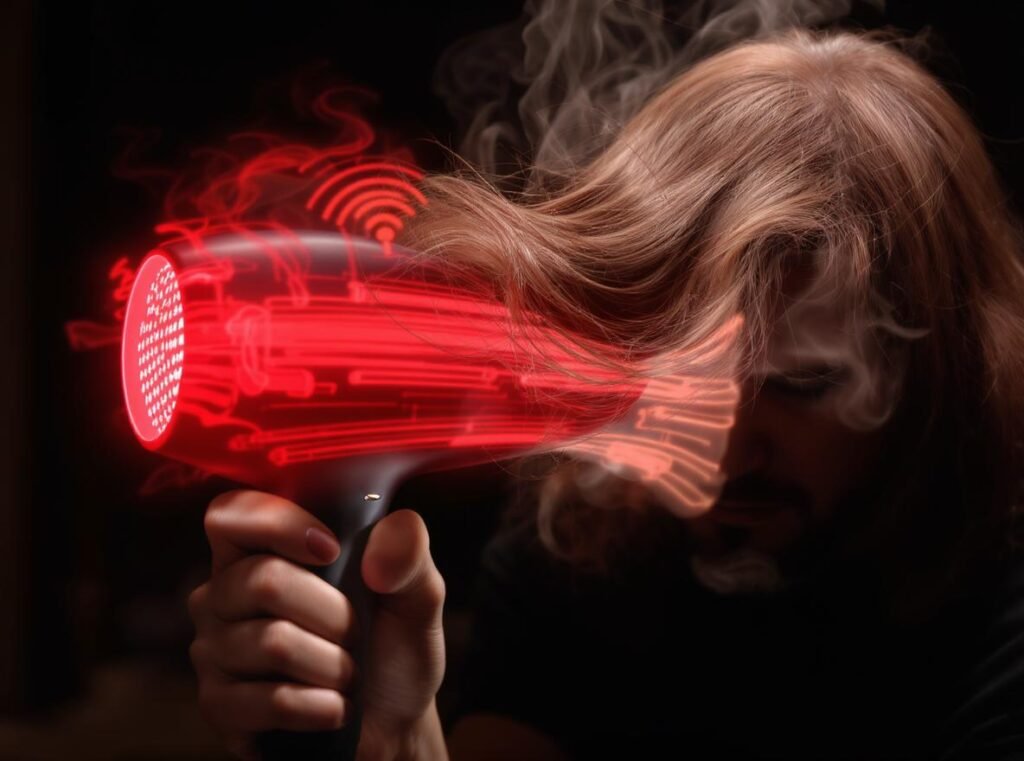
The most damaging practices include several common mistakes:
Failing to use a heat protectant product increases the risk of heat-induced damage. These products create a barrier between your hair and heat while providing beneficial conditioning agents.
Aggressive towel drying before blow-drying can cause additional friction and breakage. Rough towel rubbing weakens wet hair, making it more susceptible to heat damage during styling.
Progressive damage typically manifests as:
- Immediate: Increased frizz and static
- Short-term: Reduced shine and manageability
- Medium-term: Split ends and breakage
- Long-term: Thinning appearance and texture changes
This can sometimes lead to temporary hair loss when damage becomes severe enough to cause significant breakage or scalp irritation.
Common mistakes that accelerate damage:
- Using maximum heat settings unnecessarily
- Holding the dryer stationary in one spot
- Skipping sectioning for even heat distribution
- Blow-drying soaking wet hair without pre-drying
- Ignoring your hair type’s specific needs
Can Hair Dryers Actually Be Good for Your Hair?
Surprisingly, research shows that hair dryers can offer several benefits for hair health when used properly, challenging the assumption that all heat styling is harmful.
Using a hair dryer at a moderate temperature and at least 15 cm away with continuous movement can cause less damage than air drying, which can lead to swelling and cracking of the hair shaft if hair remains wet for too long.
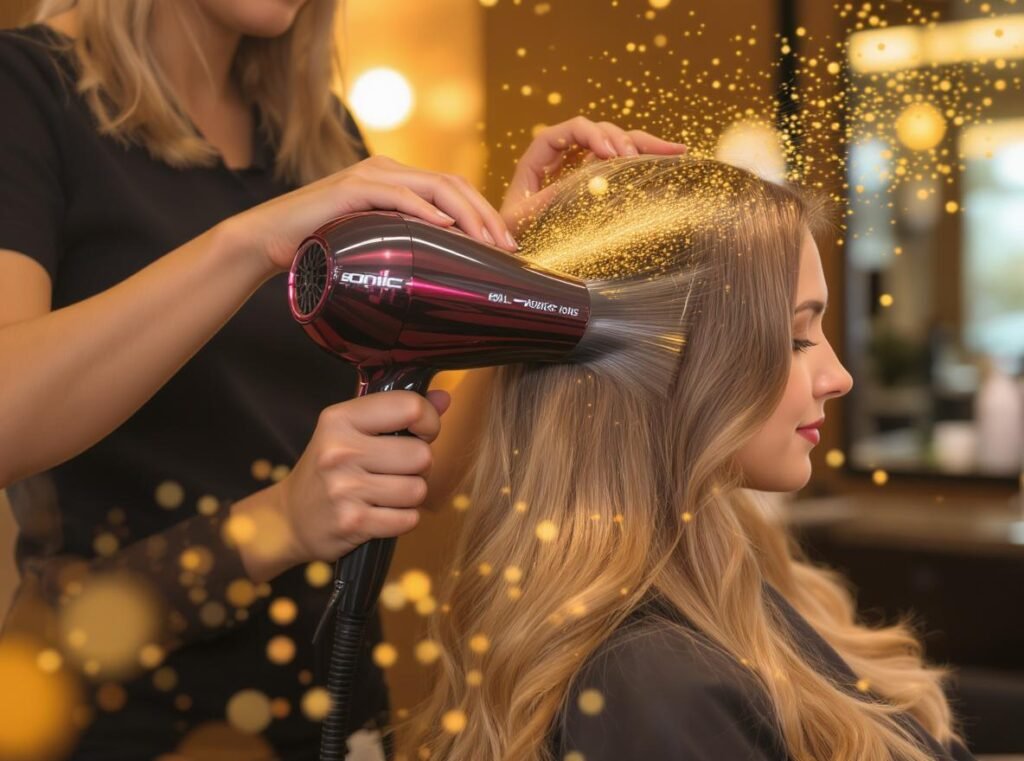
The benefits become clear when examining hair’s wet state vulnerability:
Wet hair experiences significant structural changes that increase fragility. Air drying for long periods can cause hair shaft swelling and cracking, making controlled heat drying potentially safer than extended wetness exposure.
Modern dryers with features like ion technology and far-infrared heating can help retain moisture and reduce frizz, potentially improving hair health and appearance. These advanced technologies work by:
- Breaking down water molecules for faster drying
- Sealing the hair cuticle for improved shine
- Reducing static electricity and frizz
- Providing more even heat distribution
Professional styling advantages include:
- Better shape retention with less manipulation
- Reduced need for additional styling products
- More predictable and consistent results
- Enhanced volume and texture control
Controlled drying at moderate temperatures prevents the hygral fatigue that occurs from repeated wet-dry cycles, ultimately supporting long-term hair health.
| Drying Method | Benefits | Potential Risks |
|---|---|---|
| Proper Blow-Drying | Fast, controlled, smooth results | Heat damage if misused |
| Air Drying | No heat exposure | Shaft swelling, longer wet time |
| Microfiber Toweling | Reduced friction | Incomplete drying |
How Do You Choose a Hair Dryer That Won’t Damage Your Hair?
Selecting the right hair dryer technology and features significantly impacts your hair’s health outcomes, making informed choice crucial for long-term hair wellness.
Select a dryer with adjustable heat and speed settings, using lower heat for fine or damaged hair, and higher heat only for thick or coarse hair. Ionic and infrared technology help dry hair faster at lower temperatures, reducing the risk of heat damage.

Essential technology features to prioritize:
Advanced heating systems make the biggest difference in hair health outcomes. Ion technology and far-infrared heating help retain moisture and reduce frizz while drying hair faster at lower temperatures.
Temperature control allows customization for your specific hair needs. Multiple heat settings enable you to use lower heat for fine or damaged hair, and higher heat only when necessary for thick or coarse hair.
Professional attachments enhance both safety and results. Use diffusers for curly hair and concentrators for straight styles to control airflow and minimize damage.
Key specifications to consider:
- Wattage appropriate for your hair density
- Multiple heat and speed combinations
- Cool shot function for style setting
- Lightweight design for comfortable use
- Removable filter for maintenance
For wholesale buyers and retailers, market considerations include:
The Conason P1C high-speed hair dryer exemplifies these professional features with its negative ionic technology, digital temperature display, and multiple heat settings. This model offers the controlled drying power your customers need while incorporating the latest damage-prevention technologies.
Quality indicators include manufacturer reputation, safety certifications, and professional endorsements. Avoid extremely cheap models that lack proper temperature control or safety features, as these often cause more damage than benefit.
What Are the Best Practices for Safe Hair Drying?
Implementing proper hair drying techniques protects your hair while achieving professional-looking results, regardless of your hair type or condition.
Safe hair drying involves multiple protective steps: keep the dryer at least 15 cm away from your hair and keep it moving to avoid concentrated heat, while always apply a heat protectant spray or serum before drying.

Pre-drying preparation sets the foundation for healthy results:
Always apply a heat protectant spray or serum before drying. These products create a thermal barrier while adding beneficial ingredients like proteins and moisturizers to strengthen hair during the drying process.
Blot hair gently with a microfiber towel before blow-drying to reduce friction and breakage. This gentle approach removes excess water without the aggressive rubbing that weakens wet hair strands.
Essential technique guidelines include:
- Hold the dryer at least 15 cm away from your hair and keep it moving
- Dry in small sections for even results and less overall exposure
- Start with lower heat settings and increase only if needed
- Point airflow down the hair shaft to smooth cuticles
- Finish with a cool air setting to close the cuticle and add shine
Post-drying care enhances and protects results:
- Allow hair to cool completely before styling
- Apply light leave-in treatments to sealed hair
- Avoid immediate brushing or manipulation
- Use silk or satin pillowcases to maintain smoothness
Professional tips for optimal results:
- Section hair systematically for even drying
- Use appropriate attachments for your hair type
- Maintain consistent distance and movement
- Monitor heat levels throughout the process
Does Hair Type Affect How Hair Dryers Impact Your Health?
Different hair types respond uniquely to heat styling, requiring customized approaches for optimal health and appearance outcomes.
Hair type significantly influences heat tolerance and drying requirements: fine/thin hair is more susceptible to heat damage and should always use the lowest heat setting, while thick/coarse hair can tolerate higher heat but still benefits from moderate settings and protective products.
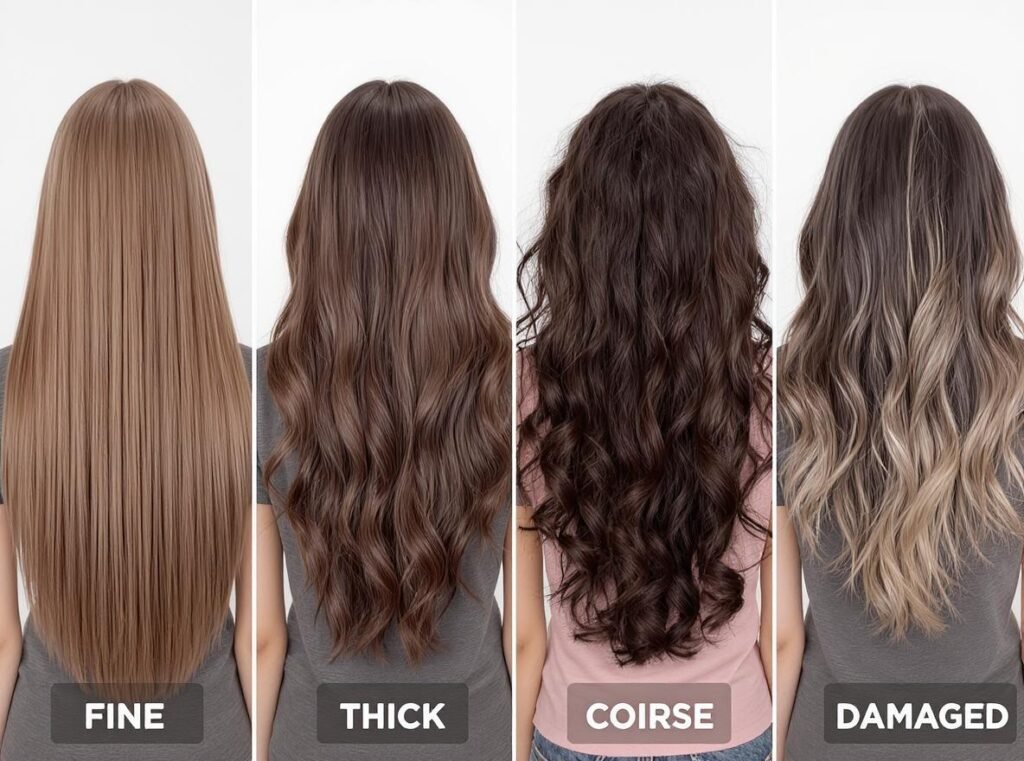
Fine and thin hair characteristics require special consideration:
Fine/thin hair is more susceptible to heat damage and should always use the lowest heat setting. These hair types heat up quickly and can become damaged at temperatures that thicker hair tolerates easily.
Recommended approach for fine hair:
- Use heat settings below 300°F
- Maintain greater distance from scalp
- Work in smaller sections for thorough drying
- Focus on root lifting rather than overall volume
- Choose ionic technology to reduce static
Thick and coarse hair presents different opportunities and challenges:
Thick/coarse hair can tolerate higher heat but still benefits from moderate settings and protective products. These hair types may require more intensive drying but should still prioritize hair health over speed.
Effective strategies for thick hair include:
- Medium to high heat settings when necessary
- More powerful airflow for efficient drying
- Larger sections for faster processing
- Professional-grade equipment for best results
- Focus on smoothing and frizz control
Curly/coily hair needs gentle, low-heat drying to maintain moisture and prevent frizz, with diffusers recommended. This hair type requires the most careful approach due to its natural fragility and tendency toward dryness.
| Hair Type | Heat Setting | Special Equipment | Key Considerations |
|---|---|---|---|
| Fine/Thin | Low (250-300°F) | Concentrator nozzle | Avoid overheating |
| Medium/Wavy | Low-Medium (300-350°F) | Diffuser or concentrator | Balance smoothing and volume |
| Thick/Coarse | Medium-High (350-400°F) | High-wattage dryer | Efficient drying with protection |
| Curly/Coily | Low (under 300°F) | Diffuser required | Preserve curl pattern |
Are There Safer Alternatives to Traditional Hair Dryers?
Modern hair care technology offers several alternatives that may provide gentler drying options, though each method presents its own benefits and limitations.
While air drying is generally less damaging, air drying for long periods can cause hair shaft swelling and cracking. Microfiber towels reduce drying time and friction compared to regular towels, and innovative tools like devices that combine drying and straightening offer less heat exposure.
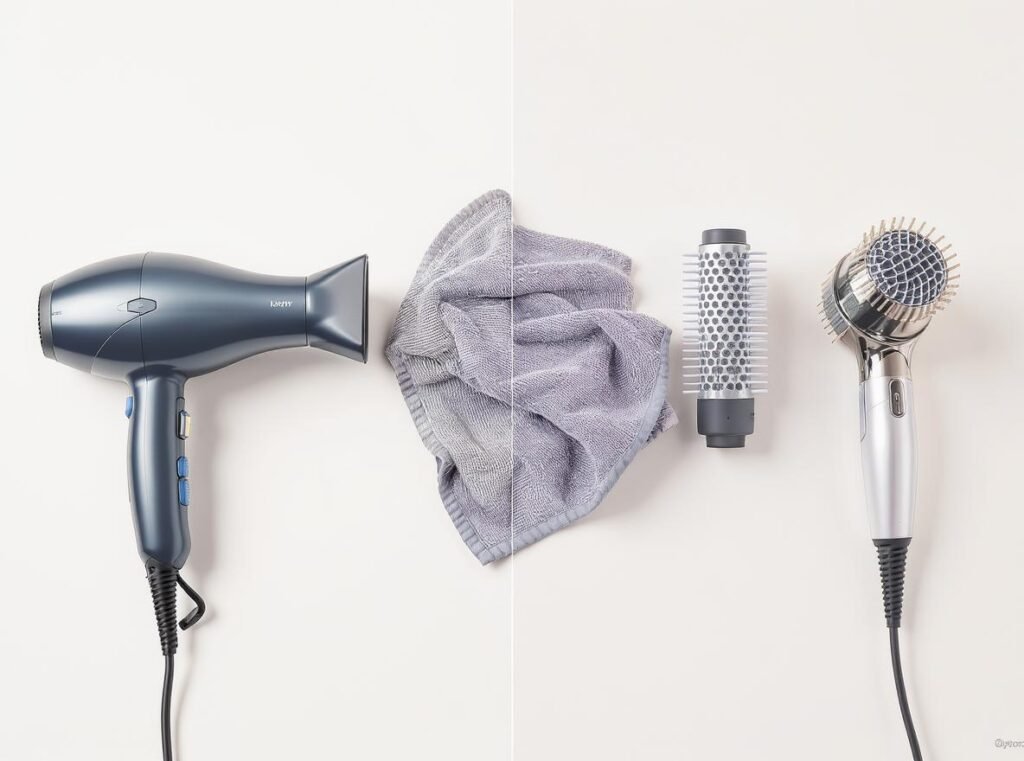
Traditional alternatives have evolved significantly:
Microfiber towels reduce drying time and friction compared to regular towels, making them an excellent first step in any drying routine. These specialized fabrics absorb more water while being gentler on hair cuticles.
Air-drying techniques can be optimized for better results. However, air drying for long periods can cause hair shaft swelling and cracking, indicating that even “natural” drying methods aren’t without risks.
Advanced technology solutions offer promising alternatives:
Innovative tools like the Dyson Airstrait combine drying and straightening with less heat exposure, and devices like the RevAir Hair Dryer offer quick, gentle drying. These represent the next generation of hair care technology.
Modern alternatives include:
- Infrared technology for deeper, gentler heat penetration
- High-velocity low-heat systems for faster drying
- Ionic technology for moisture retention
- Hybrid tools that combine multiple functions
Professional salon alternatives provide additional options:
- Steam treatments for conditioning during drying
- Specialized low-heat professional equipment
- Expert technique application
- Customized treatment combinations
For retailers and distributors, offering diverse technology options allows customers to choose based on their specific needs, hair types, and damage concerns while positioning your business as knowledgeable about hair health innovations.
How Can You Repair Hair Damage from Hair Dryers?
Existing hair damage from improper heat styling can often be improved through targeted treatments and technique adjustments, though prevention remains more effective than cure.
Effective repair strategies involve multiple approaches: deep conditioning masks and leave-in conditioners restore moisture, protein treatments help rebuild weakened hair structure, and regular trims remove split ends to prevent further breakage.
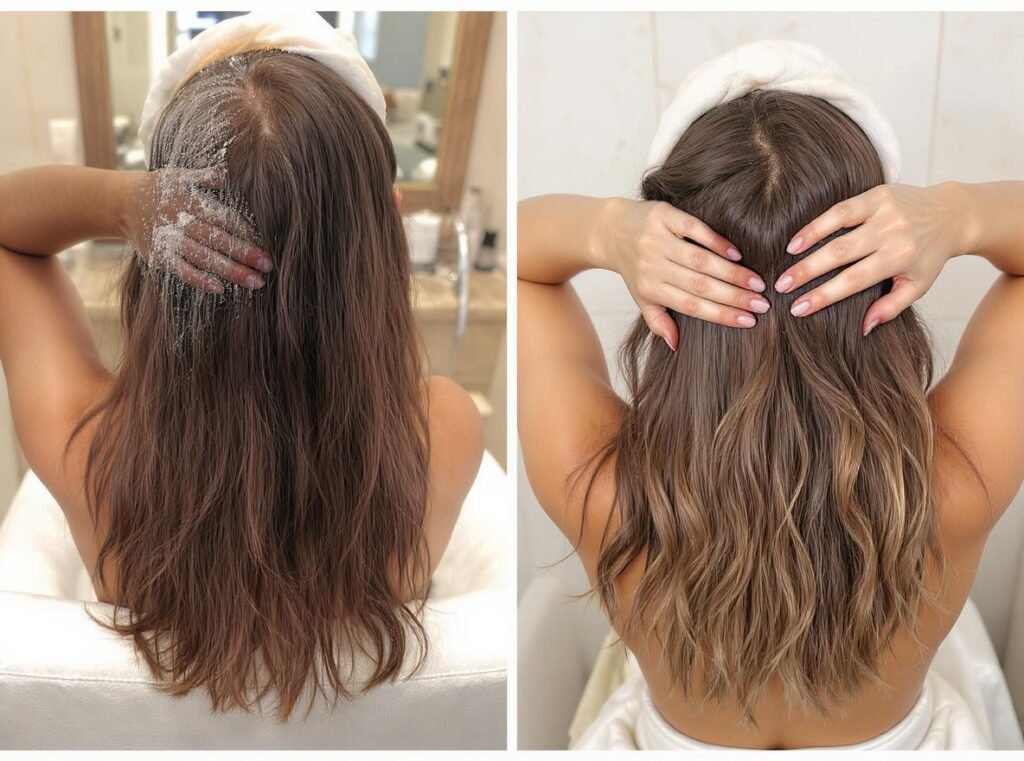
Assessment guides the appropriate treatment intensity:
Surface damage appears as increased frizz, dullness, and minor texture changes. This level typically responds well to consistent moisturizing treatments and improved styling techniques.
Structural damage includes visible split ends, significant breakage, and altered hair texture. These issues require more intensive intervention including protein reconstruction and professional consultation.
Repair protocol should follow a systematic approach:
Deep conditioning using hydrating masks and leave-in conditioners helps restore moisture that heat styling has depleted. Focus these treatments on mid-length to ends where damage typically concentrates most severely.
Protein treatments help rebuild weakened hair structure by filling in gaps in the hair shaft caused by heat damage. Use these treatments according to your hair’s specific protein needs, as overuse can cause brittleness.
Regular trimming removes split ends to prevent further breakage and maintains the overall health of your hair as it recovers from damage.
Additional recovery strategies include:
- Limiting heat styling frequency and always using protective products
- Incorporating weekly deep conditioning treatments
- Using wide-tooth combs on wet hair to prevent mechanical damage
- Sleeping on silk or satin pillowcases to reduce friction
| Damage Severity | Treatment Frequency | Expected Recovery Time | Professional Help |
|---|---|---|---|
| Surface (frizz, dullness) | Weekly deep conditioning | 4-6 weeks | Optional |
| Moderate (some breakage) | Bi-weekly protein treatments | 8-12 weeks | Recommended |
| Severe (extensive damage) | Professional consultation | 3-6 months | Essential |
Summary
Hair dryers aren’t inherently bad for your hair health when used correctly with proper technique and quality equipment. Research shows that controlled blow-drying at moderate temperatures can actually cause less damage than prolonged air-drying, while modern ionic and infrared technologies offer additional protection and benefits.
The key factors for healthy hair drying include maintaining appropriate distance and temperature, using heat protectant products, choosing equipment suited to your hair type, and understanding that fine hair requires gentler treatment than thick, coarse hair. For those in the hair care industry, offering customers advanced options like the Conason P1C with its precise temperature controls and ionic technology helps them achieve professional results while prioritizing hair health.
Ready to explore professional-grade hair dryers that prioritize hair health? Browse our complete collection of advanced hair drying technology at conason.com/product/ or contact us for wholesale inquiries to provide your customers with the latest in damage-prevention hair care innovations.


